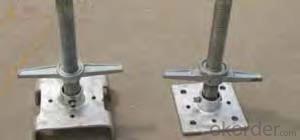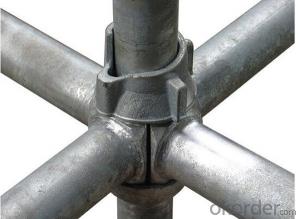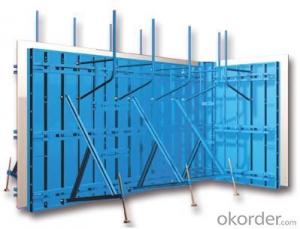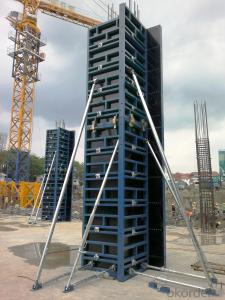Circular Column Formwork Outrigger For Scaffolding With New Design
- Loading Port:
- Tianjin
- Payment Terms:
- TT OR LC
- Min Order Qty:
- 20000 set
- Supply Capability:
- 50000 set/month
OKorder Service Pledge
OKorder Financial Service
You Might Also Like
Circular Column Formwork Outrigger For Scaffolding With New Design
Plastic Formwork Concrete Formwork Circular Column Used Scaffolding Props New Design
Developing with new technology materials, steel formworks is no longer a must in construction concrete process. More and more buildings are established with plastic formworks. And workers love this new formworks much more.
The advantages of plastic formworks:
1.First of all--light
Yes it is the first advantage of plastic formwork. It wins the great praise of both contractors and workers.
The biggest panel is 120×1500px,weights 10.5kg only. It can be lift and set up by one person easily, which means there is no need for cranes on site.Saves a lot of cost and time.
2.Easy set up
Different size of panels can firmly locked by simply turn the special handles to 90 degree. The Panels has rib on the back, which makes the system need not traditional wood blocks and nails. The panels have holes to fit tie rod, guarantee the strength of the whole system.
3.Modularity
Modular formworks composed by different size of panels..
4.Strength
The handles are made by high strength Nilon, each panel locked by at least 4 handles, which makes the whole system strong enough to pour 1000px walls.
5.Environment friendly
The system needs no cut and nail due to the variety size. Also it needs nearly no wood. The material can be recycled after broken, so it will not pollute the environment.
6.Consequent
Concrete does not stick to plastic formwork, thus the panels need no oil before using, and can be cleaned simply by water. The surface of the wall which build by modular formwork is smooth and without rework.
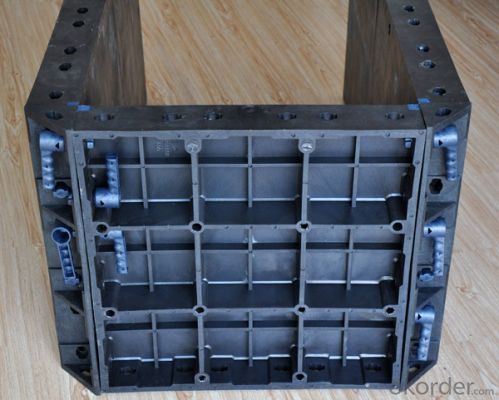
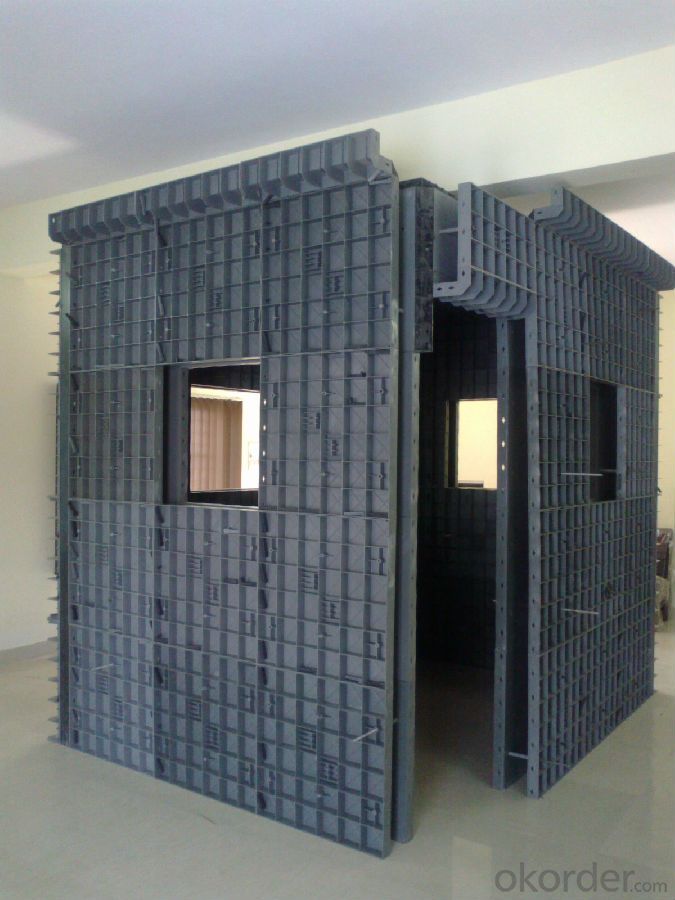
Advantage
* Good loading capacity
* Easy to assemble and dismantle
* Stable and durable thanks to its structual design & automatic welding quality
* Customized solution helps you work safe, save cost and convenient
* Excellent quality for formwork & scaffolding with wide choices
Packing
in bulk or in bundle, or as requested
Shipping
15-20 Days.
Normally small orders, it needs just 15-20 business days to the port. For goods with stock, it would be even shoter.
Other scaffolding & formwork products:
(1) Scaffolding System:
Including Ringlock Scaffolding System and accessories; Cuplock Scaffolding System and accessories; Kwikstage Scaffolding System and accessories; Haki Scaffolding System and accessories;
(2) Scaffolding Frame & Accessories:
Including Walk Through Frame Scaffolding; Ladder Frame Scaffolding; Accessories; we also can make scaffolding according to your samples or drawings.
(3) Scaffolding Couplers/Clamps:
We can produce all kinds of forged and pressed couplers, including British type couplers, American type couplers, German type couplers, Italian type couplers ,fence couplers, BRC coplers and so on. We also can produce according to your drawings or samples.
FAQ
Why Us?
We are one of the Top 500 in the world, largest construction materials supplier in China. Also we are a state-owned company and respond to every customer with large and also small orders.
We own professional manufacturers with powerful producing capacity.
Extensive and comprehensive quality control system
Excellent products with competitive prices.
Efficient services in pre and after sale.
Full energy with affluent experience team.
- Q:What are the common quality control measures for steel frame formwork systems?
- Quality control measures for steel frame formwork systems in the construction industry are implemented to guarantee the formwork system's integrity, strength, and safety during the concrete pouring process. Key quality control measures include: 1. Material Inspection: Thoroughly inspecting the materials used in the steel frame formwork system is the first step in the quality control process. This involves assessing the steel's quality, specifications, welding quality, surface finish, and overall structural strength. 2. Dimensional Accuracy: Ensuring precise dimensions and tolerances during the manufacturing of the steel frame formwork system is crucial. This requires verifying the accuracy of measurements, angles, and alignments of the formwork system components to avoid misalignment and compromised structural integrity. 3. Load Testing: Evaluating the load-bearing capacity and overall stability of the steel frame formwork system through load testing is essential. Simulated loads are applied to the system to assess its ability to withstand expected construction loads without failure or deformation. 4. Safety Inspections: Regular inspections are conducted to ensure the proper installation and functioning of safety features such as handrails, guardrails, and access points. Compliance with industry safety standards and regulations is also verified. 5. Documentation and Record Keeping: Proper documentation and record keeping play a vital role in quality control for steel frame formwork systems. This includes maintaining records of material certifications, inspection reports, load testing results, and safety compliance documents to ensure traceability and accountability. 6. Inspection of Formwork Joints: The joints between different formwork components are inspected to ensure proper alignment and integrity. Gaps, misalignments, or loose connections that could compromise the stability and strength of the formwork system are checked. By implementing these quality control measures, construction companies can ensure that steel frame formwork systems are manufactured and installed to the highest standards. This minimizes the risk of structural failures, enhances worker safety, and ensures successful completion of construction projects.
- Q:How does steel frame formwork compare to precast concrete formwork?
- Steel frame formwork and precast concrete formwork are two common construction methods used in the building industry. While both have their advantages and disadvantages, steel frame formwork offers certain benefits over precast concrete formwork. Steel frame formwork is highly flexible and adaptable, allowing for easy customization and adjustment to meet specific project requirements. It is lightweight, making it easier to handle and transport, and can be assembled and dismantled quickly. This efficiency translates into reduced construction time and improved productivity. On the other hand, precast concrete formwork involves the use of prefabricated concrete components that are manufactured off-site and then transported to the construction site. This method offers the advantage of faster installation and a smoother finish, as the precast elements are produced under controlled conditions. However, it may be less adaptable to design changes during construction and requires careful planning to ensure accurate measurements and fit. In conclusion, while precast concrete formwork has its merits in terms of speed and finish quality, steel frame formwork offers greater flexibility and efficiency, making it a preferred choice for many construction projects.
- Q:What are the different types of formwork ties used with steel frame formwork?
- There are several types of formwork ties used with steel frame formwork, each serving a specific purpose in ensuring the stability and strength of the formwork system. 1. Snap Ties: These are one of the most commonly used formwork ties and they provide a strong connection between the formwork panels. They are quick and easy to install and can be easily removed after the concrete has cured. 2. Flat Ties: Flat ties are similar to snap ties but have a flat end instead of a loop. They are used when a smooth finish is desired on the concrete surface as they leave minimal marks on the concrete after removal. 3. She-bolts: She-bolts are used to connect formwork panels together. They are designed with a threaded end that can be easily screwed into the formwork panels, providing a secure connection. 4. Wing Nuts: Wing nuts are used in conjunction with she-bolts to secure the formwork panels in place. They have two wings that can be easily turned by hand, allowing for quick and easy installation and removal. 5. Tie Rods: Tie rods are used to anchor the formwork system to the ground or other structural elements. They are typically made of steel and are threaded on both ends, allowing for easy connection and adjustment. 6. Cone Anchors: Cone anchors are used to secure the formwork system to the concrete structure. They consist of a cone-shaped anchor that is inserted into a pre-drilled hole in the concrete. The tie rod is then threaded into the anchor, providing a strong and secure connection. 7. Form Anchors: Form anchors are used to provide additional support and stability to the formwork system. They are typically made of steel and are inserted into pre-drilled holes in the formwork panels. The anchor is then secured in place with a nut and washer, providing a strong and rigid connection. These are just a few examples of the different types of formwork ties used with steel frame formwork. The choice of tie will depend on factors such as the desired finish, the structural requirements, and the specific formwork system being used.
- Q:In the process of construction of reinforced concrete frame structure, the main contents of the quality inspection and monitoring of formwork engineering
- The specifications, quality and fastening conditions of all kinds of connecting pieces and supporting parts (the use of torque wrench for fasteners); 3, the overall stability of the supporting points and the combined steel formwork;
- Q:How does steel frame formwork handle different types of concrete shrinkage?
- A versatile and durable system, steel frame formwork effectively manages various types of concrete shrinkage. During the curing process, concrete naturally undergoes shrinkage, which can be classified into two categories: plastic shrinkage and drying shrinkage. Plastic shrinkage occurs when excess water evaporates from the surface, causing a reduction in volume. To minimize water evaporation and reduce the risk of plastic shrinkage, steel frame formwork is designed with a tight seal. This also provides excellent support and stability to the fresh concrete, preventing any deformation or cracking that may result from plastic shrinkage. Drying shrinkage, on the other hand, happens as the concrete continues to cure and lose moisture over time. Steel frame formwork is engineered specifically to withstand the forces associated with drying shrinkage. The rigid structure of the steel frames ensures that the formwork remains intact and maintains its shape, even as the concrete shrinks. This is crucial in preventing any distortion or damage to the formwork, which could compromise the quality and integrity of the final concrete structure. Furthermore, steel frame formwork offers the advantage of adjustability. The modular nature of the system allows for easy modifications and adaptations to accommodate different types of concrete shrinkage. For example, if significant shrinkage is expected, additional support can be added to the formwork to ensure its stability. Conversely, if the shrinkage is minimal, adjustments can be made to reduce the overall weight and complexity of the formwork. To conclude, steel frame formwork is well-suited to handle various types of concrete shrinkage. Its tight seal minimizes plastic shrinkage, while its rigid structure withstands the forces associated with drying shrinkage. Additionally, the adjustability of the system allows for customization based on specific shrinkage characteristics. Overall, steel frame formwork provides a reliable and effective solution for managing concrete shrinkage and ensuring the successful construction of durable concrete structures.
- Q:Can steel frame formwork be customized to fit different shapes and sizes?
- Yes, steel frame formwork can be customized to fit different shapes and sizes. Its flexibility allows for adjustments and modifications, enabling it to adapt to various construction requirements and achieve precise measurements and designs.
- Q:What is the cost of steel frame formwork compared to other types of formwork?
- Various factors, such as project size, complexity, location, and specific requirements, can affect the cost of steel frame formwork. Comparatively, steel frame formwork tends to be more expensive than other materials like wood or aluminum. The higher cost of steel frame formwork primarily stems from the durability and strength of steel. Steel is renowned for its ability to withstand high loads and pressures, making it ideal for heavy-duty construction projects. Its long lifespan and resistance to wear and tear contribute to its higher price. Additionally, steel frame formwork offers several advantages over alternative forms, including better dimensional accuracy, increased stability, and enhanced reusability. These benefits, combined with steel's superior strength, make it a popular choice for large-scale construction projects that require precision and durability. While the initial investment in steel frame formwork may be higher, it proves cost-effective in the long run due to its extended lifespan and reusability. By eliminating the need for frequent replacements or repairs, steel frame formwork reduces overall project costs and improves efficiency. It is crucial to consider more than just the cost of formwork when selecting the most suitable option for a construction project. Factors like project requirements, timeline, and complexity should also be evaluated to make an informed decision. Consulting construction experts and assessing specific project needs can help determine the most cost-effective formwork solution.
- Q:What are the transportation and storage requirements for steel frame formwork?
- The transportation and storage requirements for steel frame formwork involve ensuring proper handling, protection, and organization. Steel frame formwork should be transported using suitable transportation equipment, such as flatbed trucks or trailers, to prevent damage or deformation. It is essential to secure the formwork during transportation to prevent shifting or falling. During storage, steel frame formwork should be stored in a clean and dry area, away from moisture or corrosive substances. It should be stacked in an organized manner, with proper support and separation to prevent any bending or distortion. Regular inspections should be conducted to identify any signs of damage or deterioration, and necessary maintenance or repairs should be performed promptly.
- Q:How does steel frame formwork handle different types of formwork stripping equipment?
- Steel frame formwork offers versatility and durability, effortlessly handling various types of formwork stripping equipment. The steel frames, designed for stability and support, can easily accommodate mechanical or hydraulic systems for stripping. An advantage of steel frame formwork is its ability to withstand the high pressure and force exerted during the stripping process. This is crucial when using different stripping equipment, as a robust support system is necessary for safe and efficient formwork removal. The steel frames are engineered to provide a stable and secure platform for the stripping equipment, ensuring proper alignment and compatibility with various stripping tools. This guarantees secure attachment, enabling effective and efficient formwork removal. Additionally, steel frame formwork is highly adaptable, making it suitable for use with different types of formwork stripping equipment. Whether relying on mechanical force or hydraulic power, the steel frames seamlessly accommodate and work with these diverse equipment options. In conclusion, steel frame formwork is specifically designed to handle various types of formwork stripping equipment. Its strength, stability, and adaptability make it an ideal choice for construction projects requiring efficient and safe formwork removal.
- Q:What is the average lifespan of a steel frame formwork system?
- The average lifespan of a steel frame formwork system can vary depending on various factors such as the quality of materials, maintenance, and frequency of use. However, with proper care and maintenance, a well-built steel frame formwork system can last anywhere from 10 to 20 years or even more.
1. Manufacturer Overview |
|
|---|---|
| Location | |
| Year Established | |
| Annual Output Value | |
| Main Markets | |
| Company Certifications | |
2. Manufacturer Certificates |
|
|---|---|
| a) Certification Name | |
| Range | |
| Reference | |
| Validity Period | |
3. Manufacturer Capability |
|
|---|---|
| a)Trade Capacity | |
| Nearest Port | |
| Export Percentage | |
| No.of Employees in Trade Department | |
| Language Spoken: | |
| b)Factory Information | |
| Factory Size: | |
| No. of Production Lines | |
| Contract Manufacturing | |
| Product Price Range | |
Send your message to us
Circular Column Formwork Outrigger For Scaffolding With New Design
- Loading Port:
- Tianjin
- Payment Terms:
- TT OR LC
- Min Order Qty:
- 20000 set
- Supply Capability:
- 50000 set/month
OKorder Service Pledge
OKorder Financial Service
Similar products
New products
Hot products
Related keywords
